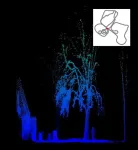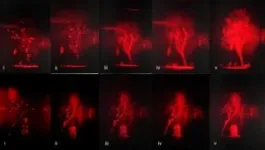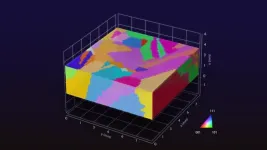(Press-News.org) Researchers have developed an augmented reality head-up display that could improve road safety by displaying potential hazards as high-resolution three-dimensional holograms directly in a driver’s field of vision in real time.
Current head-up display systems are limited to two-dimensional projections onto the windscreen of a vehicle, but researchers from the Universities of Cambridge, Oxford and University College London (UCL) developed a system using 3D laser scanner and LiDAR data to create a fully 3D representation of London streets.
The system they developed can effectively ‘see through’ objects to project holographic representations of road obstacles that are hidden from the driver’s field of view, aligned with the real object in both size and distance. For example, a road sign blocked from view by a large truck would appear as a 3D hologram so that the driver knows exactly where the sign is and what information it displays.
The 3D holographic projection technology keeps the driver’s focus on the road instead of the windscreen, and could improve road safety by projecting road obstacles and potential hazards in real time from any angle. The results are reported in the journal Advanced Optical Materials.
Every day, around 16,000 people are killed in traffic accidents caused by human error. Technology could be used to reduce this number and improve road safety, in part by providing information to drivers about potential hazards. Currently, this is mostly done using head-up displays, which can provide information such as current speed or driving directions.
“The idea behind a head-up display is that it keeps the driver’s eyes up, because even a fraction of a second not looking at the road is enough time for a crash to happen,” said Jana Skirnewskaja from Cambridge’s Department of Engineering, the study’s first author. “However, because these are two-dimensional images, projected onto a small area of the windscreen, the driver can be looking at the image, and not actually looking at the road ahead of them.”
For several years, Skirnewskaja and her colleagues have been working to develop alternatives to head-up displays (HUDs) that could improve road safety by providing more accurate information to drivers while keeping their eyes on the road.
“We want to project information anywhere in the driver’s field of view, but in a way that isn’t overwhelming or distracting,” said Skirnewskaja. “We don’t want to provide any information that isn’t directly related to the driving task at hand.”
The team developed an augmented reality holographic point cloud video projection system to display objects aligned with real-life objects in size and distance within the driver’s field of view. The system combines data from a 3D holographic setup with LiDAR (light detection and ranging) data. LiDAR uses a pulsed light source to illuminate an object and the reflected light pulses are then measured to calculate how far the object is from the light source.
The researchers tested the system by scanning Malet Street on the UCL campus in central London. Information from the LiDAR point cloud was transformed into layered 3D holograms, consisting of as many as 400,000 data points. The concept of projecting a 360° obstacle assessment for drivers stemmed from meticulous data processing, ensuring clear visibility of each object’s depth.
The researchers sped up the scanning process so that the holograms were generated and projected in real-time. Importantly, the scans can provide dynamic information, since busy streets change from one moment to the next.
“The data we collected can be shared and stored in the cloud, so that any drivers passing by would have access to it – it’s like a more sophisticated version of the navigation apps we use every day to provide real-time traffic information,” said Skirnewskaja. “This way, the system is dynamic and can adapt to changing conditions, as hazards or obstacles move on or off the street.”
While more data collection from diverse locations enhances accuracy, the researchers say the unique contribution of their study lies in enabling a 360° view by judiciously choosing data points from single scans of specific objects, such as trucks or buildings, enabling a comprehensive assessment of road hazards.
“We can scan up to 400,000 data points for a single object, but obviously that is quite data-heavy and makes it more challenging to scan, extract and project data about that object in real time,” said Skirnewskaja. “With as little as 100 data points, we can know what the object is and how big it is. We need to get just enough information so that the driver knows what’s around them.”
Earlier this year, Skirnewskaja and her colleagues conducted a virtual demonstration with virtual reality headsets loaded with the LiDAR data of the system at the Science Museum in London. User feedback from the sessions helped the researchers improve the system to make the design more inclusive and user-friendly. For example, they have fine-tuned the system to reduce eye strain, and have accounted for visual impairments.
“We want a system that is accessible and inclusive, so that end users are comfortable with it,” said Skirnewskaja. “If the system is a distraction, then it doesn’t work. We want something that is useful to drivers, and improves safety for all road users, including pedestrians and cyclists.”
The researchers are currently collaborating with Google to develop the technology so that it can be tested in real cars. They are hoping to carry out road tests, either on public or private roads, in 2024.
The research was supported in part by Stiftung der Deutschen Wirtschaft and the Engineering and Physical Sciences Research Council (EPSRC), part of UK Research and Innovation (UKRI).
END
360-degree head-up display view could warn drivers of road obstacles in real time
2023-12-20
ELSE PRESS RELEASES FROM THIS DATE:
Taking out the cellular trash
2023-12-20
If we don’t take out the trash regularly, our homes become unpleasant and even a danger to our health. The same applies to our cells: If excess proteins and strands of genetic material aren’t removed, the cell and ultimately the entire organism can fall ill. For instance, scientists suspect there is a connection between Alzheimer’s and mutations that cause defects in cellular garbage removal. What’s more, tests with mice have shown that suppressing the breakdown of DNA and RNA can trigger serious autoimmune diseases.
But concrete evidence is missing: “There’s a lot of research showing how genetic information in the ...
Aerogel can become the key to future terahertz technologies
2023-12-20
High-frequency terahertz waves have great potential for a number of applications including next-generation medical imaging and communication. Researchers at Linköping University, Sweden, have shown, in a study published in the journal Advanced Science, that the transmission of terahertz light through an aerogel made of cellulose and a conducting polymer can be tuned. This is an important step to unlock more applications for terahertz waves.
The terahertz range covers wavelengths that lie between microwaves and infrared light on the electromagnetic spectrum. It has a very high frequency. Thanks to this, many researchers ...
Slimming significantly alters your microbiome and brain activity
2023-12-20
Worldwide, more than one billion people are obese. Obesity is a risk factor for cardiovascular disease, diabetes, and some cancers. But permanently losing weight isn’t easy: complex interactions between body systems such as gut physiology, hormones, and the brain are known to work against it. One method for weight loss is intermittent energy restriction (IER), where days of relative fasting alternate with days of eating normally.
“Here we show that an IER diet changes the human brain-gut-microbiome axis. The ...
Giving video games this Christmas? New research underlines need to be aware of loot box risks
2023-12-20
Recent controversy has surrounded the concept of loot boxes – the purchasable video game features that offer randomised rewards but are not governed by gambling laws.
Now research led by the University of Plymouth has shown that at-risk individuals, such as those with known gaming and gambling problems, are more likely to engage with loot boxes than those without.
The study is one of the largest, most complex and robustly designed surveys yet conducted on loot boxes, and has prompted experts to reiterate the call for stricter enforcement around them. ...
Large language models validate misinformation, research finds
2023-12-20
New research into large language models shows that they repeat conspiracy theories, harmful stereotypes, and other forms of misinformation.
In a recent study, researchers at the University of Waterloo systematically tested an early version of ChatGPT’s understanding of statements in six categories: facts, conspiracies, controversies, misconceptions, stereotypes, and fiction. This was part of Waterloo researchers’ efforts to investigate human-technology interactions and explore how to mitigate risks.
They discovered that GPT-3 frequently made mistakes, contradicted ...
Artificial intelligence unravels mysteries of polycrystalline materials
2023-12-20
Researchers at Nagoya University in Japan have used artificial intelligence to discover a new method for understanding small defects called dislocations in polycrystalline materials, materials widely used in information equipment, solar cells, and electronic devices, that can reduce the efficiency of such devices. The findings were published in the journal Advanced Materials.
Almost every device that we use in our modern lives has a polycrystal component. From your smartphone to your computer to the metals and ceramics in your car. Despite this, polycrystalline materials are tough to utilize because of their complex structures. Along with their composition, the performance ...
Asian Fund for Cancer Research Limited unveils inspiring new logo and slogan, signifying a global commitment to advancing cancer research - from Asia to the world.
2023-12-20
The Asian Fund for Cancer Research (AFCR) is thrilled to unveil its fresh brand logo and slogan, marking a pivotal moment in the organization's quest to advance breakthroughs in cancer globally. The redesigned emblem and impactful slogan firmly establish AFCR as a prominent voice in the ongoing battle against cancer, extending its influence beyond Asia.
"Advancing Cancer Breakthroughs from Asia to the World"
This compelling slogan powerfully encapsulates AFCR's unwavering commitment to drive innovation and foster collaboration in cancer research ...
Beetroot juice supplement lowers blood pressure and improves exercise capacity in people with chronic obstructive pulmonary disease
2023-12-20
A 12-week course of daily beetroot juice supplement for people with chronic obstructive pulmonary disease (COPD) lowered blood pressure and improved how far patients could walk in six minutes in research published today (Wednesday) in the European Respiratory Journal [1].
COPD is a serious lung condition affecting around 400 million people worldwide [2]. COPD which includes chronic bronchitis and emphysema, causes breathing difficulties and severely limits people’s capacity for physical activity. It also increases the risk ...
Finding that statins could slow dementia stimulates further research
2023-12-20
Blood fat-lowering statins could slow the progression of Alzheimer's disease, at least for some patients. This is the result of a new study led by Karolinska Institutet published in Alzheimer Research and Therapy. But the researchers are cautious in their interpretations and see the results as a first step in a research journey that may eventually provide the answer.
A new study shows that people with Alzheimer's dementia deteriorated more slowly in their cognitive functions if they were also treated with a lipid-lowering ...
Potentially harmful ‘trip-killers’ to cut short ‘bad’ drug trips, emerging concern, warn doctors
2023-12-20
The use of potentially harmful ‘trip-killers’ to cut short ‘bad drug trips’ after taking psychedelics, such as LSD or magic mushrooms, is an emerging concern, warn doctors in a research letter, published online in Emergency Medicine Journal.
Their analysis of relevant threads on the social media platform Reddit, shows that drugs such as benzodiazepines (sedatives) and antipsychotics are the options most frequently recommended, but warnings about their potential side effects are rarely included, they highlight.
The intensity of a psychedelic drug trip can cause distress, agitation, ...







